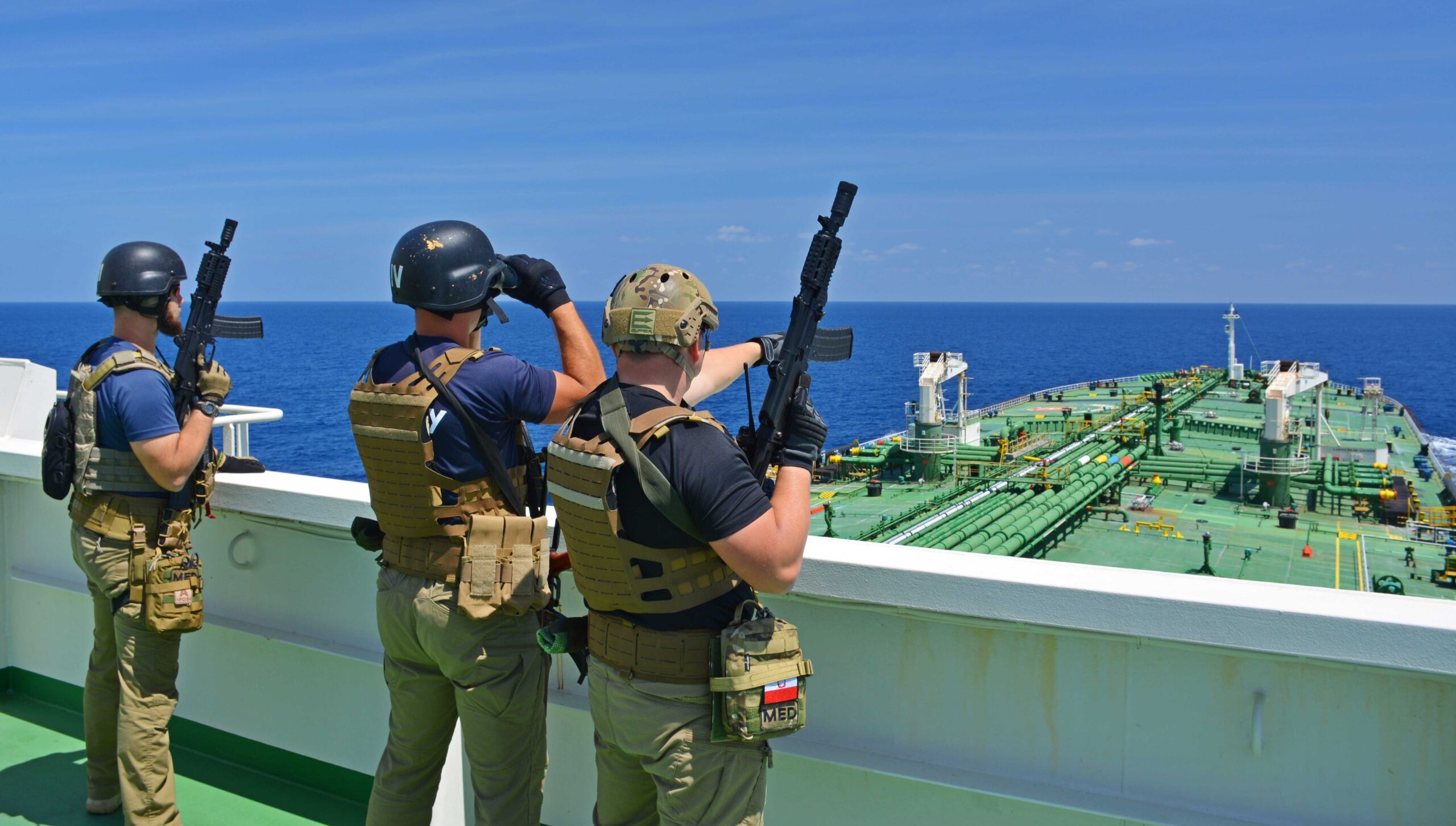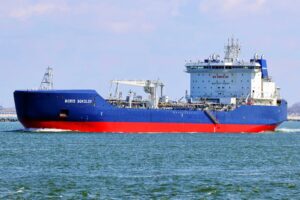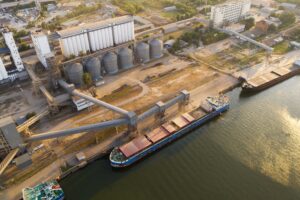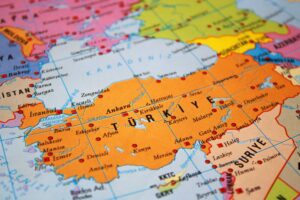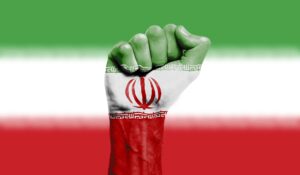A highly strategic arena for regional and international actors alike, the Red Sea serves as a critical waterway for global trade, making the Red Sea region a key geopolitical interest for Europe. With the Persian Gulf to the east and the African coast to the west, it is bounded by the Suez Canal and the Straits of Tiran in the north and the Bab al-Mandab Strait in the south. The risk of confrontation between key regional and international actors is increasing relentlessly, and has the potential to drastically disrupt trade routes which remain crucial to European interests and EU grand strategy.
The Red Sea has historically been a major conduit for European and global trade.
Crucially, European grand strategy in part promotes the critical mission of the European Union (EU) to ensure peaceful use of the seas and to safeguard the maritime domain against emerging threats. Together, the EU Member States make up the largest combined exclusive economic zone in the world,[i] and rely heavily upon a secure maritime domain to ensure safe passage for global trade and economic protection, and growth. The Red Sea has historically been a major conduit for European and global trade, benefitting foreign actors who hold a stake in the Red Sea, and littoral states alike. About 10% of all global trade passes through the Red Sea’s waters.[ii] By the year 2050, the Red Sea region’s GDP is projected to rise from $1.8 trillion to $6.1 trillion, more than tripling in size. Similarly, the region’s volume of trade, largely driven by the energy and oil sectors, is projected to expand from $881 billion to $4.7 trillion, growing fivefold in size.[iii]
In particular, the Bab al-Mandeb Strait, located between Djibouti and Eritrea in the Horn of Africa, and Yemen in the Gulf, is increasingly salient to Europe, although it is becoming progressively more affected by the economic and military entanglement of major regional players surrounding the Red Sea seeking influence and access.[iv] A vital choke point for the movement of oil and international commerce,[v] and the shortest trade route between the Mediterranean region to the west and the Indian Ocean and East Asia to the east, it funnels billions of dollars in maritime trade.[vi] Roughly 6.2 million barrels of crude oil and petroleum products pass through it every day,[vii] and over 50 million tons of agricultural products pass through it every year.[viii]
Armed Conflict and Military Entanglement
The Red Sea region presents a hotspot for armed conflict and military entanglement.
The Red Sea region presents a hotspot for armed conflict and military entanglement, which often suffocate the region’s security situation and have the potential to disrupt key trade routes in the theatre. While Somali piracy has been by and large resolved, repercussions from the Civil War in Yemen have caused irreparable disruptions. Houthi attacks on shipments and pipelines persist, posing a threat to regional and major power maritime traffic. Yemeni ports line the Bab el-Mandeb, extending north along Yemen’s coast to the Midi district in the Hajjah Governorate. Saudi Arabia’s blockade of Yemeni ports, which began at the outbreak of Yemen’s Civil War in 2015, Houthi rebels and fallout from the Civil War have caused instability for naval and commercial voyages passing through the Strait.[ix] Since the start of the Civil War, Houthi rebels and allies have captured strategic Yemeni ports and coastal areas, thereby compromising the security of shipments and naval vessels navigating through the Strait by activating explosive boats and shooting missiles to attack Western and Saudi presence in the Sea.[x]
The most recent incident occurred on March 18 of this year, when Houthi armed drones attacked a Greek commercial ship flying under a Liberian flag.[xi] Other examples include the attack in October 2022 when Yemen’s Saudi-backed government intercepted Houthi armed drones launched against the oil tanker Nissos preparing to dock at the southern al-Dhabba oil terminal, in order to load two million barrels of crude oil,[xii] the Houthi seizure of a United Arab Emirates-flagged commercial vessel off the coast of Hodeidah,[xiii] the alleged Houthi attack on a Singaporean oil tanker in 2020, and a threat to block the Strait or attack Emirati ships in 2016.[xiv] Attacks on shipments in the Red Sea have already led in several instances to the halting of transportation and the blocking of naval access to oil supply through the Suez Canal or the Sumed pipeline.
A complete closure of the Strait would have massive implications for the Red Sea region and foreign powers invested in freedom of navigation.
However, such disruption is not only limited to shipping lanes in the Red Sea. For instance, in May 2019, alleged Houthi drones struck a Saudi pipeline carrying oil to the Red Sea, forcing Saudi Arabia to move its supply through redundant pipes. Since this time, Iran-backed proxy groups in Iraq and Yemen, and possibly Iran itself, continue to pose a threat to Saudi oil facilities.[xv] Drug trafficking and the clandestine movement of arms, including from Iran to its armed groups and other arms markets, persist at high levels, feeding conflict in such fragile states as Ethiopia, Somalia, and Yemen.[xvi]
A complete closure of the Strait would have massive implications for the Red Sea region and foreign powers invested in the freedom of navigation. Because the Red Sea connects the Mediterranean to southeast Asian waters, it would force commercial maritime traffic to reroute around the Cape of Good Hope at the southern tip of Africa, dramatically increasing transit time and shipping and insurance costs, inflating prices on items such as fuel and food, and directly impacting European, American, African, and Asian markets. It would disrupt efforts by European and American powers to offer clear economic and strategic development opportunities for global and regional players in the area as well as making the delivery of European humanitarian aid and development assistance more difficult.[xvii]
This is of particular concern in recent weeks since fighting broke out in Sudan. The Sudanese humanitarian crisis is escalating quickly, with 10,000-20,000 refugees already fleeing its borders.[xviii] This has the potential to trigger a mass exodus, which would spread across the eastern coast of Africa, through the Red Sea, and into the Gulf states. Several countries have since sent military planes from Djibouti to fly people out from the capital, while others have transported people out to the Port of Sudan and boarded them onto ships to Saudi Arabia.[xix]
Geopolitical Tensions
Rivalries amongst the Gulf states also contribute to the political tensions along the coasts of the Red Sea.
Regional geopolitical tensions also have the potential to escalate conflict in the sea, and thereby affect international trade and commerce. Given the political fragmentation and “unchecked military expansionism”[xx] by many regional actors, and diverging and conflicting strategies by international ones, the European pursuit of a stable Red Sea region is a challenge.
For instance, rivalries amongst the Gulf states also contribute to the political tensions along the coasts of the Red Sea. After long-standing tensions between Saudi Arabia and Qatar came to a boiling point in 2017, the Saudi-led coalition of the EU, Egypt, and Bahrain launched a political and economic boycott of Qatar, including commercial ports and military posts on Africa’s Red Sea coast.[xxi]
Iran, Turkey, and Egypt also vie for maritime dominance. Regional developments could incentivise naval exercises to turn into naval attacks, and misinterpreted military posture could incite real harm in the politically unstable region. Iranian sea power in the region continues to support the Houthi rebels in Yemen, and its naval exercises project a forward military posture against Europe and its allies. Allegedly, Islamic Revolutionary Guard Corps (IRGC) naval vessels have been active in the Red Sea over the past year, with warships patrolling the southern region. Former Israeli Minister of Defence, Benny Gantz, has noted that in the latter half of 2022, identified Iranian military presence on the sea, and against Israel, has drastically increased as compared to the last decade,[xxii] inspiring the Israeli Defence Forces to announce on April 23rd that they are preparing for a deteriorating naval situation in the Red Sea.[xxiii] The U.S. has already deployed a guided-missile submarine to a Naval fleet patrolling crucial straits in the Red Sea to strengthen deterrence against Iran.[xxiv][xxv]
As Iran and Saudi Arabia have jockeyed for regional hegemony in recent years, their efforts have played out to deadly effect in Syria, Yemen, and into the Red Sea.
The Iranian presence has not been static. On November 18, 2022, an Iranian-made drone attacked a British vessel in the Gulf of Oman.[xxvi] On July 2, 2022, Iran-backed Hizballah in Lebanon allegedly sent three drones towards an Israeli offshore gas rig. While the Israeli military interrupted the attack, [xxvii] several months later on September 2, 2022, the IRGC briefly captured two U.S. unmanned surface vehicles (USV) on the Red Sea before returning them to U.S. custody the following day.[xxviii] This incident came days after the IRGC attempted to capture a U.S. USV in the Persian Gulf.[xxix] These are just several moments in a pattern of Iranian proactive military policing that can endanger regional stability, engender further naval and military activity, and pose a threat to international shipping, including that of Europe and its allies.
As Iran and Saudi Arabia have jockeyed for regional hegemony in recent years, their efforts have played out to deadly effect in Syria, Yemen, and into the Red Sea. In recent months, the two rivals have begun the process of normalizing their relations to bring stability to the region and its waterways. Even if that process endures and matures, there is still a long way to go until their new arrangements effect positive change. [xxx] The outcome of Iran’s commitment to de-escalatory measures in Yemen is still uncertain, especially since Saudi Arabia has been exploring enhancing ties with Israel in an effort to contain Iran.[xxxi]
International Presence
At this point in time, there is very little EU defence presence in the Red Sea.
The involvement of foreign powers also can potentially escalate conflict in the sea and could cause a partial or complete closure of the Bab el-Mandeb Strait and other such crucial waters as the Strait of Hormuz. Major economic expansion in the Red Sea theatre is vital to China’s interests, with the state intending to establish additional Silk Road passages in the region.[xxxii] China established a support base in Djibouti in 2017 less than 20 km from [xxxiii] where, in 2001, the U.S. established its primary naval base for the U.S. Africa Command in the Horn of Africa.[xxxiv] Since 2001, China has begun to conduct Naval exercises in this region. Russia also plans to build a military base in Sudan,[xxxv] likely to be consonant with Russia’s plans for the Wagner Group, a semi-private military company often used to carry out illegal activity and Russian military operations in other countries. Such a base would allow the Wagner group to provide arms and military assistance to Russian points of interest in the region, including Sudan and Yemen. It would also allow Russia to project its sea power, increasing its naval capabilities to combat Chinese, European, and American presence in the region.
At this point in time, there is very little EU defence presence in the Red Sea; only France and Italy have bases in Djibouti.[xxxvi] In 2018, France commenced a joint exercise with Egypt in the Red Sea[xxxvii] and, in 2022, has expressed plans for operational deployment in the Mediterranean Sea with the possibility of setting course to the Red Sea to protect the interests of the North Atlantic Treaty Organization.[xxxviii]
The EU...must continue to build upon, and promote, its policies and interests in the region.
In order for the EU and its Member States to protect its trade routes and other maritime interests in the Red Sea, it must continue to build upon, and promote, its policies and interests in the region. In February 2022, funded by the EU, and in partnership with Interpol, Global Management and Crime Program, and the International Maritime Organization, the Regional Programme for Maritime Security in the Red Sea Area was launched. Established in February 2021, this project is to be funded until November 2024, and focuses on supporting the development and implementation of maritime legislation and security measures as well as the development of a port security management system and port state compliance in the Red Sea littoral states of Djibouti, Eritrea, Ethiopia, Somalia, Sudan, and Yemen.[xxxix]
The European Council has also committed itself to extending its missions and operations in the Horn of Africa, including the Naval Force Operation ATALANTA until the end of December from its establishment in 2008. Its mission is to deter and prevent crimes in the Red Sea, including piracy and trafficking. It also intends to continue contributing to strengthening Somali maritime law enforcement capacity.[xl]
Policy Recommendations
The complex nature of the Red Sea requires a holistic and layered approach to combating today’s and tomorrow’s threats and challenges.
In order for Europe to protect its interests in the Red Sea, it must ensure that such missions are effective and inclusive. First, the EU must ensure that its internal organisations involved in Red Sea security closely coordinate among them in information sharing and collaboration to create a holistic approach; it is imperative that the EU engages diplomacy, military, policing efforts, and trade and commerce in its Red Sea posture.
Continued interaction and capacity building with Red Sea littoral states is also important; it could potentially allow for further cooperative policy within the region to address Red Sea states’ political and military infrastructure, capitol, and capacity needs. Pursuing increased cooperative policy options may also prevent militarisation of the maritime domain and potential conflict in the region from escalating.
At the very least, the EU should host a Red Sea summit with its partners and allies from Europe and beyond who hold a stake in the region. Here, EU Member States and their allies could express their mutual interest in securing the Red Sea’s waterways and help to quickly find cooperative solutions to tackle current and emerging threats. Such states must enact policies to build up the region’s naval diplomacy and sea power capabilities without the need for Red Sea states to rely on competing powers such as China and Russia.
The EU has the opportunity to advance its grand strategy interests and protect its economy.
The complex nature of the Red Sea requires a holistic and layered approach to combating today’s and tomorrow’s threats and challenges to the security of trade routes in its maritime domain. A more hands-on and comprehensive European policy could enhance regional capabilities to protect and defend against risks to successful trade in the Red Sea. Europe must continue to take these threats and opportunities seriously and enact policy in the Red Sea in line with its current maritime approach. This is the only way to effectively secure freedom of navigation throughout the sea. With a creative and flexible strategy in the Red Sea, the EU has the opportunity to advance its grand strategy interests and protect its economy.
[i] “Maritime Security: EU Updates Strategy to Safeguard Maritime Domain Against New Threats,” European Commission (European Commission, March 10, 2023), https://ec.europa.eu/commission/presscorner/detail/en/ip_23_1483.
[ii] Nathanael C Heath, “A Red Sea Geopolitics Primer,” The Fares Center (The Fletcher School of Law and Diplomacy, Tufts University, June 19, 2020), https://sites.tufts.edu/farescenter/a-red-sea-geopolitics-primer/.
[iii] Fahd Al Rasheed, “Red Sea – Artery of Global Trade,” Arab News (Saudi Research & Publishing Company, February 11, 2016), https://www.arabnews.com/columns/news/879221.
[iv] Ibid.
[v] Nabil Sharaf, “Increasing Contestation over the Red Sea and Horn of Africa,” Arab Center Washington DC (Arab Center Washington DC, April 9, 2021), http://arabcenterdc.org/policy_analyses/increasing-contestation-over-the-red-sea-and-horn-of-africa/.
[vi] Helal Aljamra, “Bab-El-Mandeb, Gateway to the Red Sea: The World’s Most Dangerous Strait,” Inside Arabia (Inside Arabia, August 1, 2019), https://insidearabia.com/bab-el-mandeb-gateway-to-the-red-sea-the-worlds-most-dangerous-strait/.
[vii] U.S. Energy Information Administration, “The Bab El-Mandeb Strait Is a Strategic Route for Oil and Natural Gas Shipments,” U.S. Energy Information Administration (EIA) (U.S. Energy Information Administration, August 27, 2019), https://www.eia.gov/todayinenergy/detail.php?id=41073.
[viii] Thomas Spence, “READ: Strategic Approaches to Maritime Chokepoints in a Globalized World – Case Studies in Bab El-Mandeb,” floats (floats, February 5, 2020), https://floatsea.org/compass/2020/2/4/strategic-approaches-to-maritime-chokepoints-in-a-globalized-world-case-studies-in-bab-el-mandeb.
[ix] Hannah Kuperman, “Securing the Bab El-Mandeb: Can Threats to the Red Sea Drive Regional Cooperation?,” Gulf International Forum (Gulf International Forum, April 1, 2021), https://gulfif.org/securing-the-bab-el-mandeb-can-threats-to-the-red-sea-drive-regional-cooperation/.
[x] Ibid.
[xi] Saeed Al-Batati, “Ship Attacked from Houthi-Held Area in Yemen ,” Arab News (Arab News, March 18, 2023), https://www.arabnews.com/node/2271086/middle-east.
[xii] Mohammed Alghobari, “Yemeni Government Forces Intercept Houthi Drones Attacking Southern Oil Terminal,” Reuters (Reuters, October 21, 2022), https://www.reuters.com/world/middle-east/yemeni-government-forces-intercept-houthi-drones-attacking-southern-oil-terminal-2022-10-21/.
[xiii] U.S. Department of Transportation, “2022-003-Persian Gulf, Strait of Hormuz, Gulf of Oman, Arabian Sea, Gulf of Aden, Bab Al Mandeb Strait, Red Sea, and Western Indian Ocean-Threats to Commercial Vessels,” U.S. Department of Transportation: Maritime Administration (U.S. Department of Transportation, 2022), https://www.maritime.dot.gov/msci/2022-003-persian-gulf-strait-hormuz-gulf-oman-arabian-sea-gulf-aden-bab-al-mandeb-strait-red.
[xiv] Sharaf, “Increasing Contestation over the Red Sea and Horn of Africa”.
[xv] Isabel Coles, “U.S.: Saudi Pipeline Attacks Originated from Iraq,” The Wall Street Journal (Dow Jones & Company, June 2019), https://www.wsj.com/articles/u-s-saudi-pipeline-attacks-originated-from-iraq-11561741133.
[xvi] Elana Delozier, “The Washington Institute for Near East Policy,” The Washington Institute for Near East Policy (The Washington Institute for Near East Policy, April 2021), https://www.washingtoninstitute.org/media/4433, 7.
[xvii] Achim Wennmann and Fiona Davies, “Economic Dimensions of the Conflict in Yemen: Final Report,” Organisation for Economic Co-operation and Development (Organisation for Economic Co-operation and Development, October 19, 2020), https://www.oecd.org/mena/competitiveness/economic-dimensions-conflict-Yemen-october-2020-wennmann-davies-eu-ocha-undp.pdf, 6.
[xviii] Mahamat Ramadane, “Un Agency in Chad Expects More Sudan Refugees,” Reuters (Reuters, April 22, 2023), https://www.reuters.com/world/africa/un-agency-chad-expects-more-refugees-fleeing-sudan-2023-04-22/.
[xix] “Photos: Sudanese and Foreigners Escape Deadly Conflict,” Al Jazeera (Al Jazeera, April 27, 2023), https://www.aljazeera.com/gallery/2023/4/27/photos-sudanese-and-foreigners-escape-during-letup-in-fighting.
[xx] Luigi Narbone and Cyril Widdershoven, “The Red Sea Link. Geo-Economic Projections, Shifting Alliances, and the Threats to Maritime Trade Flows.” (European University Institute, Robert Schuman Centre for Advanced Studies, July 2021), https://cadmus.eui.eu/bitstream/handle/1814/72105/QM-03-21-328-EN-N.pdf, 15.
[xxi] Zach Vertin, “Red Sea Geopolitics: Six Plotlines to Watch,” Brookings (The Brookings Institution, March 2022), https://www.brookings.edu/research/red-sea-geopolitics-six-plotlines-to-watch/.
[xxii] “Israel Says Iran Military Build up in Red Sea Is Threat to Stability,” Reuters (Reuters, July 5, 2022), https://www.reuters.com/world/middle-east/israel-says-iranian-warships-have-been-patrolling-red-sea-2022-07-05/.
[xxiii] “Iranian Ships Based in the Red Sea Threaten International Maritime Trade,” I24news (i24 NEWS, April 23, 2023), https://www.i24news.tv/en/news/israel/defense/1682251924-iranian-ships-based-in-the-red-sea-threaten-international-maritime-trade.
[xxiv] “US Deploys Guided-Missile Submarine amid Tensions with Iran,” AP NEWS (Associated Press, April 8, 2023), https://apnews.com/article/gulf-tensions-us-submarine-iran-74d6bc9cf2b8781edab7b081151914ae.
[xxv] Farzin Nadimi, “U.S. Deploys Cruise Missile Submarine to Strengthen Deterrence against Iran,” The Washington Institute (The Washington Institute, April 14, 2023), https://www.washingtoninstitute.org/policy-analysis/us-deploys-cruise-missile-submarine-strengthen-deterrence-against-iran.
[xxvi] “Britain Says Drone Circles Vessel in Gulf of Oman after Strike on Tanker,” Reuters (Reuters, November 18, 2022), https://www.reuters.com/world/ukmto-aware-drone-circling-vessel-gulf-oman-statement-2022-11-18/.
[xxvii] “Israel Says Iran Military Build up in Red Sea Is Threat to Stability,” Reuters (Thomson Reuters, July 2022), https://www.reuters.com/world/middle-east/israel-says-iranian-warships-have-been-patrolling-red-sea-2022-07-05/.
[xxviii] Mallory Shelbourne, “Iran Temporarily Captures Two U.S. Saildrones in Red Sea,” USNI News (USNI News, September 3, 2022), https://news.usni.org/2022/09/02/iran-temporarily-captures-two-u-s-saildrones-in-red-sea.
[xxix]Karoun Demirjian, “U.S. Navy Interrupts Iranian Attempt to Seize Vessel in Persian Gulf,” The Washington Post (WP Company, August 30, 2022), https://www.washingtonpost.com/national-security/2022/08/30/navy-drone-iran-persian-gulf/.
[xxx] Julien Barnes-Dacey, Cinzia Bianco, and Ellie Geranmayeh, “The Shoots of Stability: What the Saudi-Iran Deal Means for the Middle East and Europe,” ECFR (ECFR, March 14, 2023), https://ecfr.eu/article/the-shoots-of-stability-what-the-saudi-iran-deal-means-for-the-middle-east-and-europe/.
[xxxi] Ibid.
[xxxii] Mattew Funaiole and Jonathan Hillman, “China’s Maritime Silk Road Initiative: Economic Drivers and Challenges,” ed. Nicholas Szechenyi, accessed 2022, https://csis-website-prod.s3.amazonaws.com/s3fs-public/publication/180404_Szechenyi_ChinaMaritimeSilkRoad.pdf, 21.
[xxxiii] “Ace Of Bases,” The Economist (The Economist Newspaper, May 2022), https://www.economist.com/special-report/2022/05/20/ace-of-bases.
[xxxiv] “Camp Lemonnier, Djibouti,” Military Bases (Military Bases, March 2022), https://militarybases.com/overseas/djibouti/lemonnier/.
[xxxv] Samy Magdy, “Sudan Military Finishes Review of Russian Red Sea Base Deal,” AP NEWS (Associated Press, February 11, 2023), https://apnews.com/article/politics-sudan-government-moscow-803738fba4d8f91455f0121067c118dd.
[xxxvi] Zvi Mazel, “The Red Sea Becomes a Dangerous Flash Point,” GIS (Geopolitical Intelligence Services AG, May 16, 2022), https://www.gisreportsonline.com/r/council-red-sea-basin/.
[xxxvii] “Egypt-France Naval Manoeuvre Begins,” Middle East Monitor (Ardi Associates Ltd, September 16, 2022), https://www.middleeastmonitor.com/20220916-egypt-france-naval-manoeuvre-begins/.
[xxxviii] Xavier Vavasseur, “French CSG Deploys for Mission Antares,” Naval News, November 16, 2022, https://www.navalnews.com/naval-news/2022/11/french-csg-deploys-for-mission-antares/.
[xxxix] “Red Sea Project,” IMO (International Maritime Organization), accessed April 26, 2023, https://www.imo.org/en/OurWork/Security/Pages/RedSeaProject.aspx.
[xl] “Operation Atalanta, EUTM Somalia and EUCAP Somalia: Mandates Extended for Two More Years – Somalia,” European Council (European Union, December 23, 2020), https://reliefweb.int/report/somalia/operation-atalanta-eutm-somalia-and-eucap-somalia-mandates-extended-two-more-years.


